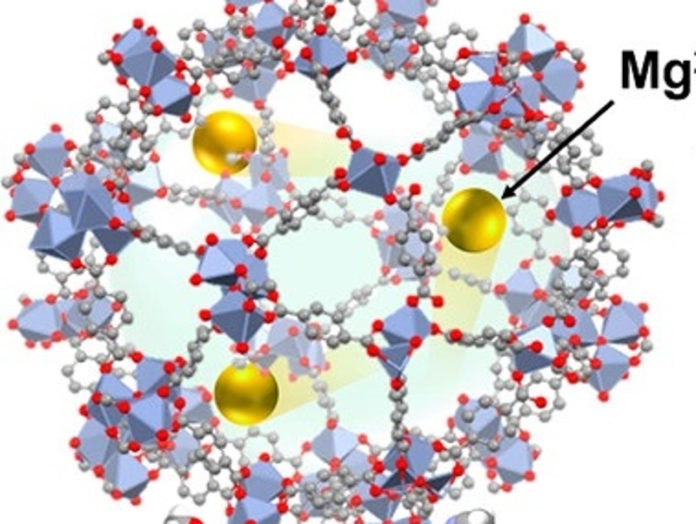
Image: JACS
Out with lithium, in with magnesium
Lithium is widely used in batteries in applications from small personal electronic devices up to electric vehicles and large-scale utility energy storage. But there are constant concerns about whether the supply can keep up with the growing demand as these technologies proliferate.
Magnesium has been gaining interest as a widely available alternative but its application has been limited by its poor conductivity in solids at room temperature. Now, with magnesium within the form of a metal-organic framework and with the introduction of the compound acetonitrile, used mainly as a solvent in refineries, a team from the Tokyo University of Science have reported overcoming this hurdle.
In essence, metal-organic frameworks have highly porous structures with space for efficient migration of the included ions, in this case the magnesium, which are enhanced by the acetonitrile.
With this work, the way is opened for the development of solid state Mg-ion batteries with the magnesium in this form, while for the researchers the quest is for even higher conductivity conductors.
For the birds
French DSO Enedis along with the TSOs RTE and Elia and other partners are working with the League for the Protection of Birds (Ligue de Protection des Oiseaux, LPO) to reduce the impact of powerlines, poles and pylons on the mortality of 13 endangered bird species in Europe.
The Safelines4birds project, with a €14 million ($14.4 million) budget including support from the European Commission’s LIFE programme, is due to start in January 2023 and run for six years. It is focused in particular on France, Belgium and Portugal.
During the project, some 4,000 avifauna beacons will be installed as a visual warning to birds of the presence of lines and cables, along with 150 platforms for stork nesting and neutralisation and deterrent devices on 750 electricity poles in the countries.
The three countries have more than 180,000km of HV lines and 1.65 million km of MV and LV lines with millions of birds said to die each year from percussion or electrocution.
Along with the white and black storks, other species of concern include little bustard, bearded, cinereous and Egyptian vultures, Bonelli’s eagle, lesser kestrel, common crane, osprey, Eurasian woodcock, Eurasian curlew and northern lapwing.
Sicily hydrogen innovation lab
Enel Green Power’s plan to build an industrial-scale innovation laboratory in Sicily has been given a boost with funding from the EU’s IPCEI Hy2Tech hydrogen initiative programme.
The NextHy Hydrogen Industrial Lab is intended to accelerate the implementation of green hydrogen technologies and the green hydrogen business and Enel Green Power plans to use it to collaborate with start-ups and other players to develop, test and validate new production and storage components and technologies.
The lab with a 4MW electrolysis system will be integrated with the existing Carlentini wind farm and also grid connected to reflect the activity of a full scale plant, while the green hydrogen output will be offtaken by Sapio for supply to industrial customers.
The location of the lab near Carlentini is just 30km south from Enel’s Catania Innovation Hub, where the company will scout and host startups.
“Just as Silicon Valley is the best place for digital, Etna Valley is becoming the ‘Energy Valley’, the best place for the global energy revolution,” declares Enel’s chief innovability officer, Ernesto Ciorra.
Landfill methane for Bitcoin mining
Vespene Energy is a Berkeley, California-based company with the vision of converting methane gas released from landfills into power for Bitcoin mining.
Now with funding of $4.3 million from the blockchain investment firm Polychain Capital and others, the company plans to pilot its micro-turbine technology in the ‘golden state’, which it says, will be a first.
Each Vespene module with a capacity of about 1.5MW is expected to take from four to six months to establish and should eliminate an estimated 270,000t CO2e per year.
According to Vespene citing EPA and NASA data, the approximately 2,600 landfills in the US account for between 15% and 45% of the country’s methane emissions and as many as three-quarters of them do not have a viable use for the methane they produce.
Vespene’s business model provides a potential revenue stream for landfill owners, while also providing a cheap, renewable energy source for its Bitcoin mining centres.
“By using wasted methane to power bitcoin mining, Vespene is killing two birds with one stone – mitigating harmful emissions and helping transition Bitcoin mining toward carbon-neutral and carbon-negative energy sources,” the company says.